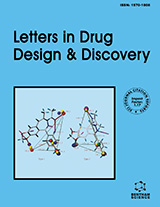Abstract
In this review we present algorithms for classification and taxonomy based on information entropy, followed by structure-activity relationship (SAR) models for the inhibition of human prostate carcinoma cell line DU-145 by 26 derivatives of N-aryl-N-(3-aryl-1,2,4-oxadiazol-5-yl)amines (NNAs). The NNAs are classified using two characteristic chemical properties based on different regions of the molecules. A table of periodic properties of inhibitors of DU-145 human prostate carcinoma cell line is obtained based on structural features from the amine moiety and from the oxadiazole ring. Inhibitors in the same group and period of the periodic table are predicted to have highly similar properties, and those located only in the same group will present moderate similarity. The results of a virtual screening campaign are presented.
Keywords: Structure-activity relationship; SAR; virtual screening; equipartition conjecture; Information entropy; N-aryl-N-(3-aryl-1, 2, 4-oxadiazol-5-yl)amine derivative; periodic law; periodic property; periodic table.
Current Computer-Aided Drug Design
Title:Information Theoretic Entropy for Molecular Classification: Oxadiazolamines as Potential Therapeutic Agents
Volume: 9 Issue: 2
Author(s): Francisco Torrens and Gloria Castellano
Affiliation:
Keywords: Structure-activity relationship; SAR; virtual screening; equipartition conjecture; Information entropy; N-aryl-N-(3-aryl-1, 2, 4-oxadiazol-5-yl)amine derivative; periodic law; periodic property; periodic table.
Abstract: In this review we present algorithms for classification and taxonomy based on information entropy, followed by structure-activity relationship (SAR) models for the inhibition of human prostate carcinoma cell line DU-145 by 26 derivatives of N-aryl-N-(3-aryl-1,2,4-oxadiazol-5-yl)amines (NNAs). The NNAs are classified using two characteristic chemical properties based on different regions of the molecules. A table of periodic properties of inhibitors of DU-145 human prostate carcinoma cell line is obtained based on structural features from the amine moiety and from the oxadiazole ring. Inhibitors in the same group and period of the periodic table are predicted to have highly similar properties, and those located only in the same group will present moderate similarity. The results of a virtual screening campaign are presented.
Export Options
About this article
Cite this article as:
Torrens Francisco and Castellano Gloria, Information Theoretic Entropy for Molecular Classification: Oxadiazolamines as Potential Therapeutic Agents, Current Computer-Aided Drug Design 2013; 9 (2) . https://dx.doi.org/10.2174/1573409911309020009
| DOI https://dx.doi.org/10.2174/1573409911309020009 |
Print ISSN 1573-4099 |
| Publisher Name Bentham Science Publisher |
Online ISSN 1875-6697 |
 11
11
- Author Guidelines
- Bentham Author Support Services (BASS)
- Graphical Abstracts
- Fabricating and Stating False Information
- Research Misconduct
- Post Publication Discussions and Corrections
- Publishing Ethics and Rectitude
- Increase Visibility of Your Article
- Archiving Policies
- Peer Review Workflow
- Order Your Article Before Print
- Promote Your Article
- Manuscript Transfer Facility
- Editorial Policies
- Allegations from Whistleblowers
Related Articles
-
Withdrawal Notice: Preparation and Applications of Glyconanoparticles
Current Drug Targets Molecular Modelling, Design, Synthesis and Biochemical Evaluation of a Range of Non-Steroidal Thiosemicarbazone-Based Inhibitors of Estrone Sulfatase (ES) - A Potential Insight into the Action of a Range of Allosteric Inhibitors of ES
Letters in Drug Design & Discovery Novel Biological Agents for the Treatment of Hormone-Refractory Prostate Cancer (HRPC)
Current Medicinal Chemistry Inhibitors of the PI3K/Akt/mTOR Pathway: New Hope for Breast Cancer Patients
Recent Patents on Anti-Cancer Drug Discovery Fork Head Transcription Factors
Current Genomics Plasticity of Neuroendocrine-Immune Interactions During Ontogeny: Role of Perinatal Programming in Pathogenesis of Inflammation and Stress- Related Diseases in Adults
Recent Patents on Endocrine, Metabolic & Immune Drug Discovery (Discontinued) IO Nation: The Rise of Immuno-Oncology
Current Pharmacogenomics and Personalized Medicine 177Lu-DOTA-Bevacizumab: Radioimmunotherapy Agent for Melanoma
Current Radiopharmaceuticals Signaling Through Rho GTPase Pathway as Viable Drug Target
Current Medicinal Chemistry The mTOR Signaling Network: Insights from Its Role During Embryonic Development
Current Medicinal Chemistry Angiogenesis Inhibition in the Treatment of Prostate Cancer
Anti-Cancer Agents in Medicinal Chemistry Adenovirus-based Immunotherapy for Prostate Cancer
Current Cancer Therapy Reviews The Interaction of Isoflavone Phytoestrogens with ER<sub>α</sub> and ER<sub>β</sub> by Molecular Docking and Molecular Dynamics Simulations
Current Computer-Aided Drug Design Positron Emission Tomography in the Diagnosis and Treatment Management of Tuberculosis
Current Pharmaceutical Design Biomarker Discovery and Translation in Metabolomics
Current Metabolomics Inflammation, Microenvironment, and the Immune System in Cancer Progression
Current Pharmaceutical Design Current Targets for Anticancer Drug Discovery
Current Drug Targets Interplay between DNA Methyltransferase 1 and microRNAs During Tumorigenesis
Current Drug Targets Differential Gene Expression of BRCA1, ERBB2 and TP53 Biomarkers between Human Breast Tissue and Peripheral Blood Samples of Breast Cancer Patients
Anti-Cancer Agents in Medicinal Chemistry Extraction, Chemical Composition, Antioxidant Property, and <i>In-vitro</i> Anticancer Activity of Silymarin from <i>Silybum marianum</i> on Kb and A549 Cell Lines
Current Drug Discovery Technologies


























